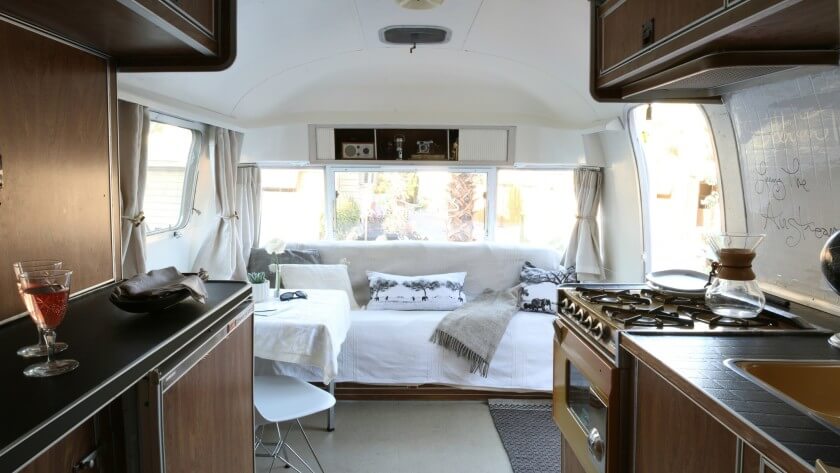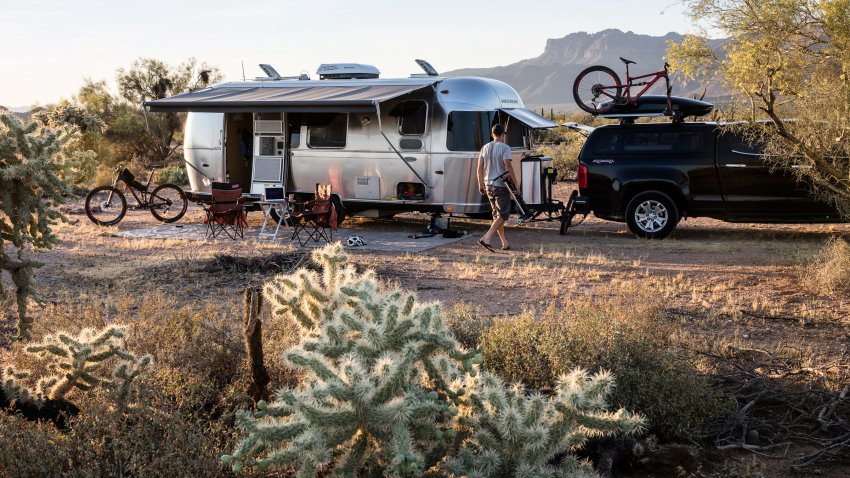How to Live on the Road in an Airstream Without Losing Your Job
For the last year, my wife and I have looked at our daily existence wake, office, exercise, bills, and commitments, social engagements, sleep, then do it all again and wondered, “What’s next?” Ours are already independent lives (Jen’s a travel photographer and I’m a contributing editor to Outside and freelance journalist), yet despite the assignments, road time, and constantly changing workflow, we feel stuck.
There never seems to be enough time for the camping trips, the hunting, the fishing, the climbing, the riding adventures, and the time outdoors that we crave.
A decade ago, struggling with similar stress, we saved some cash, quit our magazine jobs, and took 16 months to vagabond around the globe. “Why not do it again?”
I’ve often said to Jen in the past few years. But we’re both farther in our careers, have a house that we built and other commitments and anyway, those creepy middle-agers haunting the youth hostels make everyone uncomfortable.

Jen has advocated for a travel trailer for a couple of years. I, in my stodgy, recalcitrant way, have resisted: because of the expense, because of the complication, but most importantly because it doesn’t fit my idea of getting outside.
Over years of expeditions on big peaks, rock climbing trips, winter camping, backpacking, and exploring the backcountry, I’ve come to love sleeping under the stars, and to my mind, RVing is decidedly not that.
“If you need all the comforts of home,” I’ve often remarked while looking at travelers in trailers and RVs, “why not just stay home.”
But Jen said something important a few months ago: “It’s not about camping. It’s about a lifestyle.” We’ve rented a casita and spent a few months each year in Tucson for the past few winters to escape the cold and snow, and her argument was that a trailer would allow us to go to other spots, too.
We’ve also intended to visit faraway friends more often, in Wyoming, Oregon, California, and beyond, as well as check out parks and wilderness areas we’ve never seen, including Big Bend and the Badlands.
But the distances and time commitments have long deterred us. “We can work from anywhere. It could be our mobile office,” Jen maintained.
For her birthday in March, Jen rented an Airstream and found a spot to set up for a week of dry camping (e.g. no hookups) on state trust land outside of Gold Canyon, Arizona. It was a test run, of sorts. But I was still skeptical.
And then a funny thing happened: I loved it.

We were the only people for miles in that stretch of the Sonoran Desert, with saguaros standing sentinel over our camper and sunset views on the jaggy Superstition Mountains.
Jen had insured the spot had cell service, and with the camper batteries to power our equipment and a table to set up on, we were able to work and write and file our respective assignments.
We found a network of trails from our doorstep that we didn’t know existed and spent the cool evenings riding and exploring. We were outside almost constantly, with deer and javelina wandering past and every meal taken in the shade of the awning.
It was like a work retreat, and I realized that it wouldn’t have been possible without the trailer. I don’t mind sleeping on the ground and dirt bagging it for recreation, but to maintain a work schedule, I need a reasonable workspace, solid sleep, a place to keep up with hygiene, and power to run it all.
Within a month, we found and purchased our own Airstream, a 2014 Flying Cloud 23FB strike while the iron’s hot and all of that. Jen, who has taken up bow hunting and fly-fishing in the last year, named the Airstream Artemis after the Greek goddess of the hunt, wild animals, and the wilderness because we see her as our muse for a wilder, freer lifestyle. This is, we hope, the beginning of the next phase in our lives as Modern Nomads.
Over the coming months and years, we’ll document our travels in a regular column, hopefully as both inspiration and a helpful how-to guide.
There’s so much talk these days of digital commuting and simplifying your life and casting off the expectations of how we’re supposed to live, but what does that actually mean in the field?
Is the road life truly freeing or are the constant movement, the juggling of mundane issues like bills and mail, and the finicky nature of travel trailers simply more complication?
Can you really live and work out of a mobile, 200 square feet? And if so, what does it take to get set up off the grid, what devices and apps facilitate mobile connectivity from the wilds, and what do you need to make it comfortable and workable?
We plan to spend most of our time dry camping (or boondocking, in RV parlance) on public lands, so part of the goal is to unearth some quiet, wild corners.
We also hope to turn up stellar trails, rivers, crags, beaches, and other wilderness escapes we might not have otherwise found, like Gold Canyon.
But mostly, we’re Airstreaming into the unknown with the hope of rediscovering some simplicity and balance in our lives and a connection to the outdoors that too often gets lost.
After picking up Artemis in Tucson, our first stop was the same desert recluse in Gold Canyon where we’d celebrated Jen’s birthday. It’s the ideological birthplace of this plan and returning felt like a pilgrimage.
At sunset on night one, I rode singletrack by headlamp, ending on a dusky descent down the dust and chunder of Quartz Ridge, then showered under the full moon with the open-air fixture.
We ate steaks and sipped bourbon out front till late, counting falling stars once the moon had set. We slept inside with windows and doors wide open under a heavy duvet to keep off the chill of the desert night. It wasn’t camping how I’ve long conceived of it, but truthfully and don’t tell Jen it might have even been better.

